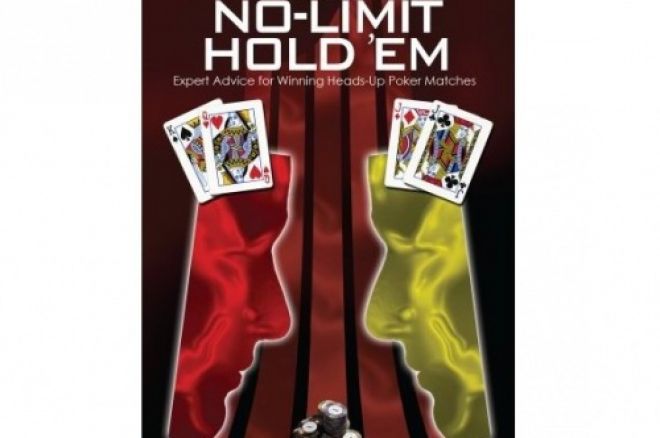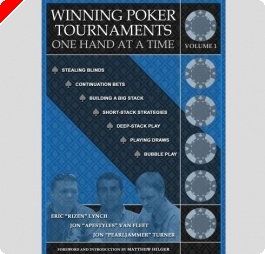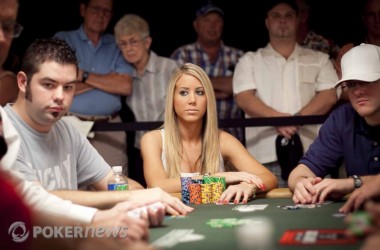Poker Book Review: Collin Moshman's 'Heads-Up No-Limit Hold'em'

Action. What most poker players crave. The more they play, the more they need. Understanding this principle, one sees how poker's recent history �� particularly the evolution of players' preferences for various forms of online play �� has followed what might in hindsight be considered a predictable sequence.
We've seen how no-limit games tend to attract far more players than their limit counterparts. We've noticed turbo-style tourneys gaining in popularity versus slower-structured events. Also, we're witnessing both cash game players and those who specialize in tournaments increasingly making the choice to play against fewer opponents, thereby seeking games in which one can (and should) play a higher percentage of hands. Thus have short-handed (six-max) tournaments become more attractive to players, as have sit-n-gos (versus MTTs). On the cash side, more players are also selecting short-handed ring games. And many players are also �� both in cash games and in tourneys �� taking the ultimate step and choosing to play heads-up, that variety of poker in which one is always, by necessity, in "action".
Following up on last year's well-received Sit 'n Go Strategy, Collin Moshman has responded to this trend with another helpful strategy guide, this time specifically geared toward heads-up play. In Heads-Up No-Limit Hold'em: Expert Advice for Winning Heads-Up Poker Matches, Moshman clearly outlines a comprehensive strategy for heads-up NLHE, providing numerous tips and advice of use in both cash games and tournaments, as well as for live and online play. While the book is not specifically geared toward the beginner (who probably should not be starting with heads-up games, anyway), Heads-Up No-Limit Hold'em is nevertheless written for a wide audience, and both intermediate and advanced players should benefit significantly from Moshman's instruction.
The book is organized into seven parts, beginning with "The Fundamentals." As Moshman himself suggests, it is probably safe for experienced players to move quickly through this introductory discussion of principles like pot odds, expected value, effective stack sizes, and other basic ideas (e.g., fold equity, showdown equity, continuation betting, value betting).
Part Two ("Playing Styles and Exploiting Styles") then describes different playing styles and the relative merits and deficits of each. Throughout this part (and the book as a whole), Moshman unambiguously favors aggression as the "one common element" to all consistently winning styles of heads-up play. Moshman outlines basic characteristics of the four primary styles one tends to encounter at the tables (loose-aggressive, tight-aggressive, loose-passive, loose-aggressive), explaining both how they are played and how best to exploit or counter them in others. One also finds in this part more particular issues being addressed, such as the "hit-to-win" approach one sometimes finds taken by the tight-passive player.
The third part, "Pot Size Manipulation," introduces the useful "bets-per-hand" concept to help one arrive at an ultimate pot size that fits with one's goals for a particular hand. That is, depending on the situation, one may wish to limit the amount of "bets" (a rough estimate standing for, say, a two-thirds pot-sized bet) that ultimately go in the middle. Other useful concepts emerge here in the context of pot control, including "process of elimination" (when deciding between available options) and "price-setting the river" (i.e., making a blocking bet in an effort to keep the pot a desirable size).
The next part, "Crucial Heads-Up Concepts and Situations," is the longest of the book, comprising over a third of its length. This part collects twenty or so short chapters that focus on a wide variety of heads-up specific issues. These discussions range from the general (e.g., calling button raises, attacking button limps, slowplaying) to very specific circumstances like "Committing All Your Chips with Ace-King" or "When the Turn Brings an Overcard." Toward the end of this part come a couple of chapters addressing heads-up matches involving players of markedly different skill levels and/or experience. Both chapters provide some interesting examples showing how an amateur player might play the same hand much differently than a professional.
For most of the book, Moshman tends not to differentiate too greatly between cash games and tournaments, as much of his advice tends to apply equally well to both formats. Part Five, "Cash and Tournament Formats," does address certain factors that are distinct to each, such as the increasing blinds, the ability to rebuy, and the rake.
It is in this part that Moshman answers a common tournament-related question regarding the notion of "effective stack sizes." Throughout the book, Moshman insists that in all heads-up situations it is only meaningful to talk of "effective stacks" (i.e., whatever the smaller of the two stacks happens to be). In a chapter titled "Are Effective Stacks Really Enough?" Moshman responds to the argument that when heads-up in a tournament, having a larger or shorter stack should have some effect on one's decision-making. Moshman's response here is that "from a math perspective" it is "incorrect" in heads-up situations not to understand that "the effective stack is the only stack-related criterion necessary for making strategy decisions."
The last two parts "step back" (so to speak) to discuss broader issues, "The Metagame" (Part Six) and "Career Play" (Part Seven), adding more worthwhile advice regarding issues like pace-setting, tilt control, timing tells, among other issues specific to heads-up play. The book then concludes with appendicies containing information about preflop hand probabilities, drawing odds, and starting hand rankings.
The book is well written and the ideas are communicated in a clear, well-organized fashion throughout. One especially valuable aspect of the book is Moshman's method of illustrating his many concepts and theories with sample hands, a technique he had also successfully employed in his previous book, Sit 'n Go Strategy. In Heads-Up No-Limit Hold'em, the majority of sample hands come from the 2005 NBC National Heads-Up Poker Championships, and the selections neatly illustrate (sometimes uncannily so) Moshman's points in ways that are quite helpful.
While Heads-Up No-Limit Hold'em might appear a highly specialized book in what is already an admittedly specialized category (i.e., poker strategy books), the discussions that appear in Moshman's book should prove useful to players who do not specialize in heads-up games as well.
Moshman does cover what he calls the "accidental heads-up" situation that arises in full ring games (e.g., blind-vs.-blind confrontations), there acknowledging that possessing a sound heads-up strategy can help one in certain circumstances not necessarily focused upon heads-up play. Even so, as anyone who has played cash games and tournaments knows full well, one often finds oneself after the flop in heads-up situations, in which case many of the concepts and strategies expounded on in Moshman's book should be of benefit to all poker players.
Thus might one argue that Heads-Up No-Limit Hold'em warrants a place on any serious poker player's bookshelf, including the bookshelves of those players who do not fancy themselves heads-up specialists. Because even if you're not one of those players constantly hoping to find action, if you're playing poker, the action will find you.








